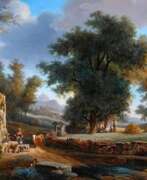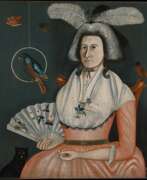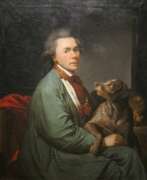Animalists 18th century


Carl Daniel David Friedrich Bach was a German artist of the late eighteenth and early nineteenth centuries, the Baroque period. He is known as a painter, graphic artist and printmaker.
Bach worked in the historical genre, was a portraitist, animalist, created canvases on allegorical subjects in the spirit of his era. In his works he combined elements of baroque and classicism. The artist often worked in the etching needle technique.


Elias Baeck called "Heldenmuth", was a German painter and engraver from Augsburg. Baeck worked for some time in Rome, then in Laybach, but finally returned to Augsburg, where he died in 1747. His chief works — both in painting and engraving — were portraits and landscapes. His engravings are sometimes signed "E.B.a.H.", standing for "Elias Baeck, alias Heldenmuth".


James Barenger is a British animal artist and illustrator.
He was born James Barenger Sr. James Barenger was a metal chaser and naturalist painter. Barenger specialized in depicting horses, dogs, and other animals, as well as noblemen's hunting scenes, which were consistently successful in the 19th century.
Barenger's patrons included the Duke of Grafton, the Marquis of Londonderry and the Earl of Derby. The artist produced entire series of prints depicting hunting, shooting, bullfighting and horse racing, which were published in sporting publications.
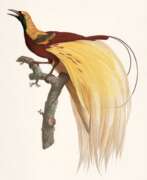

Jacques Barraband was a French zoological and botanical illustrator, renowned for his lifelike renderings of tropical birds. His pictures were based on mounted specimens and his illustration was considered the most accurate ones made during the early 1800s.




Marmaduke Cradock was an English painter of birds and animals.
Sketches in the collection of the British Museum indicate that he based at least some of the birds in his paintings on drawings from life. He tended to paint domestic birds and common wild species, rather than the exotic varieties favoured by some other artists. He sometimes introduced elements of drama such as attacks by predatory animals into his bird paintings, a feature shared with the works of Francis Barlow.


René Gaillard, a French artist of the 18th century, is recognized for his work in colored etching and engraving. His piece "Les Amans Surpris" (The Surprised Lovers), created after François Boucher, is an example of his craft and is housed within the collection of The Metropolitan Museum of Art. This work, a depiction of a romantic encounter, echoes the Rococo style prevalent during his time.
Gaillard's contributions to the world of French printmaking remain accessible and celebrated. His techniques and artistic choices, from the chosen subject matter to the subtleties of his engravings, offer a window into the rich artistic culture of 18th-century France.
For collectors and enthusiasts eager to explore the depths of Rococo printmaking, Gaillard’s works offer a unique glimpse into the past. The Met's Open Access policy allows for the public domain image of "Les Amans Surpris" to be freely used, inviting all to engage with Gaillard's legacy.




Johann Friedrich Grooth (Russian: Иван Фёдорович Гроот) was a German painter, celebrated for his exquisite animal paintings. Born in 1717 in Stuttgart, Grooth moved to St. Petersburg in 1743 where he would make his mark as a court painter to Empress Elizabeth Petrovna of Russia. His specialized talent in depicting animals with lifelike accuracy earned him high respect and prestigious commissions at the Russian court.
Grooth's artistry was particularly notable in his attention to detail, capturing the delicate features of bird feathers and animal fur. His works often portrayed scenes with animals and birds, rendered with such realism that they served not only as art but also as educational models in the Russian Academy of Arts, where he later taught.
Among his renowned works is "Two Toy Spaniels at a Sugar Bowl," painted in 1757, which exemplifies his skill in capturing the essence of his subjects. This painting, like many of his works, is celebrated for its intricate detail and vibrant life, capturing the spirit of the animals he painted so fondly.
For collectors and art enthusiasts interested in the unique blend of German artistry and Russian imperial history, Johann Friedrich Grooth's works are a testament to the rich cultural interplay of the 18th century. To stay updated on new acquisitions and auction events featuring Grooth's work, sign up for our newsletter.


Johann Jakob Haid, a prominent German engraver and portraitist, was renowned for his work in Augsburg during the 18th century. Born into a family of artists, Haid's legacy is particularly noted for his exquisite mezzotint portraits. His career also involved a stint in England, where he was influenced by the works of English mezzotint engraver Robert Robinson.
Haid's artistic prowess was not limited to portraiture. He ventured into botanical illustration, contributing significantly to Johann Wilhelm Weinmann's "Phytanthoza iconographia". This collaboration showcases his versatility and technical skill in different art forms.
Collectors and experts in art and antiques often seek Haid's works for their unique artistic value and historical significance. His contributions to the art world, especially in mezzotint engraving, continue to be appreciated and studied. His works are a testament to the rich cultural and artistic heritage of Germany.
For those interested in the world of art and antiques, particularly in the realm of engraving and painting, Johann Jakob Haid remains a figure of significance. To stay updated on new product sales and auction events related to Johann Jakob Haid, sign up for our updates. This subscription is an excellent way to stay informed about the latest developments and opportunities in the field.


Carl Adolph Heinrich Hess was a German animalist, battalionist and teacher. He studied the works of the old masters at the Dresden Gallery.
Carl Adolph Heinrich Hess travelled extensively in Russia, Hungary, Turkey and Britain, studying different breeds of horses and achieved mastery in their portrayal.
He lived in Vienna from 1808, where he taught at the Academy of Fine Arts. In 1825 he published a collection of life-size lithographs of horse heads.
He was an honorary member of the Berlin Academy of Arts.


Johann Joachim Kändler was a German sculptor and porcelain artist best known for his role in transforming European porcelain, particularly through his work at the Meissen porcelain factory. His sculptures and figurines, characterized by their natural motifs and intricate details, significantly impacted the porcelain industry.
Kändler's early works often depicted elements from nature, with his bird sculptures—such as those of jays and woodpeckers—being particularly notable. As his career evolved, he delved into smaller decorative figures, such as those from the "Swan Service," a collection of detailed and delicate porcelain pieces. Kändler also drew inspiration from the commedia dell'arte, a popular form of theater, creating vibrant figurines that captured the spirit of this genre. His "Monkey Band" from 1753 is an enduring piece still celebrated today.
Throughout his career, Kändler produced over a thousand different items, many of which are now considered timeless masterpieces in European porcelain art. You can find his works in museums and galleries, such as the British Museum, Seattle Art Museum, and The Metropolitan Museum of Art. Some pieces are even available for auction or sale, often fetching high prices due to their rarity and artistic significance.
If you'd like to learn more about Johann Joachim Kändler or stay updated on related sales and auctions, you can subscribe to our newsletter for timely information and insights into his works.


Karl Kuntz was a German painter of the late eighteenth and first third of the nineteenth centuries. He is known as a painter, graphic artist and printmaker.
Karl Kuntz specialized in small landscapes and animal images. His works were characterized by fine detail and realism. Kuntz's landscapes reflected real places, sometimes with slight artistic additions. He created images of animals based on Dutch traditions and elevated them to a high level of art. As an engraver, the artist worked mainly in the aquatint technique. In 1829 he was appointed director of the Royal Gallery in Karlsruhe by Grand Duke Ludovic of Baden, but he passed away a year after this appointment.


Francesco Ladatte was an Italian sculptor. At birth, his surname was somewhat different - Ladetti. The name Ladatte was the result of "Frenchization" after Francesco moved from Italy to Paris. He is sometimes referred to as François Ladatte.
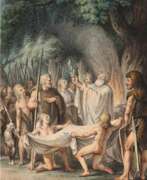

Johann Michael Mettenleiter was a German artist, born in 1765, who left an indelible mark in the fields of drawing, etching, copper engraving, and lithography. His dedication to art was not just confined to creating works but also extended to establishing a lithographic institution and field printing office for the Russian Tsar Alexander I in Warsaw in 1818, a feat that earned him the prestigious Saint Stanislaus Order.
In 1824, Johann Michael Mettenleiter's contributions to art were further recognized when he was honored as an honorary member of the Royal Bavarian Academy of Fine Arts. Despite a severe accident in 1844, his influence continued until his death in 1853 in Passau. His legacy is carried on through his pupils, including his stepsons and his nephew, Johann Evangelist Mettenleiter.
One of Johann Michael Mettenleiter's notable works, "Ariovistus in confrontatie met Caesar, 58 v.C.," created in 1808, captures a historical scene with precision and is housed in the Rijksmuseum. His artworks, like this one, offer a glimpse into the depth and diversity of his skills, showcasing his mastery in capturing historical narratives through art.
For art collectors and enthusiasts, Johann Michael Mettenleiter's works represent a fascinating blend of historical storytelling and artistic prowess. His pieces, whether in private collections or public museums, continue to inspire and captivate audiences, underscoring the timeless appeal of his artistry.
If Johann Michael Mettenleiter's fusion of history and art intrigues you, sign up for updates and stay informed about upcoming sales, exhibitions, and auctions featuring his works. Delve deeper into the world of a visionary artist who bridged the gap between the past and the present through his captivating creations.


Balthasar Paul Ommeganck was a distinguished Flemish painter, born in Antwerp, Belgium, in 1755. He garnered acclaim for his unique approach to landscape painting, blending realism with an idealized portrayal of nature. Ommeganck's work is characterized by detailed observation of nature, a sure line, and subtle use of color. His favorite subjects were undulating landscapes, often featuring grazing animals like cows, sheep, and goats.
Balthasar Paul Ommeganck's talent was not confined to painting alone; he was also a skilled draughtsman and dabbled in sculpture, producing some clay models of sheep and cows. His main contribution to art was combining the light found in Dutch Italianate painters' work from the 17th century with meticulous observation of nature, finding a synthesis between realism and an idealized representation of nature.
In 1799, Balthasar Paul Ommeganck's landscape painting won the first prize in Paris, a competition he had not intended to enter but was submitted to by a friend. His success extended beyond the borders of Belgium, as he became a member of several academies, including those in Amsterdam, Brussels, Ghent, Munich, and Vienna. In 1809, he was recognized as a corresponding member of the Institut de France.
Despite his death in 1826, Balthasar Paul Ommeganck's style continued to influence landscape painting in the 18th and early 19th centuries. However, later art critics have sometimes viewed his adherence to classic tradition and preference for the picturesque and conventional as a form of 'hopeless traditionalism'.
For collectors and enthusiasts of art and antiques, Balthasar Paul Ommeganck's works represent a significant period in the history of landscape painting. His paintings, with their fusion of realistic detail and atmospheric beauty, are a testament to his skill and vision.
To keep abreast of the latest news, sales, and auction events related to Balthasar Paul Ommeganck's art, consider subscribing to our updates. This service ensures you stay informed about opportunities to delve deeper into the works of this notable landscape artist.






Luisa Ignacia Roldán Villavicencio, known as La Roldana, was a Spanish sculptress of the Baroque period and the first female sculptor in Spain about whom there is verified lore. In the Museum of the Latin American Society, Roldán is described as "one of the few female artists who had their own workshop outside the convent in Golden Age Spain". Her father Pedro Roldán was also a sculptor from Seville.


Francis Sartorius the Elder was a British animal painter.
Francis was the son and pupil of John Sartorius (c.1700-1780), an animal painter and founder of a four-generation dynasty of the famous Sartorius family of artists.
Francis Sartorius was a prolific and popular artist whose main subject matter was horses, racing and hunting scenes. He also collaborated with magazines as an illustrator.
His son John Nost Sartorius (1759-1828) and grandson John Francis Sartorius (1775-1831) were also famous horse painters.


Johann Jakob Schalch was a Swiss painter. He was a contemporary of the Swiss painters Anton Graff, Jean Preudhomme, Angelica Kauffman, Jakob Emanuel Handmann, Johann Caspar Füssli. His son Johann Heinrich Füssli was also a noted painter.
Schalch was noted for his paintings of the Rheinfall in Schaffhausen, many of which were reproduced as engravings, making his name well-known.
The Museum zu Allerheiligen in Schaffhausen owns the largest collection of Schalch paintings and drawings.


Aert Schouman or Aart Schouman was an 18th-century painter, now better known as a glass engraver, from the Dutch Republic. He was a prolific and versatile Dutch painter, glass engraver, printmaker, collector and dealer, who produced still lifes, biblical and mythological themes, natural history studies, genre, historical and topographical works, portraits, sketches, etchings and mezzotints. He designed tapestries, painted wall-hangings and decorated objects such as fans, snuffboxes and even the glass windows of a magic lantern. From 1742 until 1792 he was head of the Dordrecht Guild of St. Luke, and in 1751 he became regent of the Hague drawing school associated with the Confrerie Pictura of The Hague. In 1736 he founded the "Brotherhood" of the Confrerie in The Hague, a fraternity of amateur art lovers from Dordrecht and environs, of which he was headman during the years 1752–1762.


Massimiliano Soldani or Massimiliano Soldani Benzi was an Italian baroque sculptor and medallist, mainly active in Florence. Soldani developed into one of the finest bronze casters of his time in Europe. Though first specialising as a medallist, Soldani also produced bronze reliefs, bronze vases and free-standing figures and busts.


Jan van Huchtenburgh was a Dutch painter of the Dutch Golden Age who specialised in battle scenes and landscapes.
Jan van Huchtenburgh was known for his ability to create dramatic and dynamic battle scenes, often depicting historical events of the 17th and 18th centuries. His work is noted for its precision and attention to detail, as well as his use of light and shadow to create a sense of depth and drama.
In addition to battle scenes, Huchtenburg was also a skilled landscape painter. He often depicted scenes of the Dutch countryside with rolling hills, winding rivers and expansive skies.


Jan van Os was a Dutch painter and a member of the renowned Van Os family of artists. He was born in Middelharnis. He was taught by Aert Schouman in The Hague, where he would spend the rest of his life. In 1773, he recorded in the painters' confraternity. Van Os is mostly known for his fruit and flower still life paintings, though he started his career painting seascapes. His floral still lifes were painted in the style of Jan van Huysum, with the flowers usually presented on a marble ledge against a green background. He was the father of artists Pieter van Os, Maria Margaretha van Os, and Georgius Jacobus Johannes van Os and grandfather to the painter Pieter Frederik van Os.


Maria Margaretha van Os was a 19th-century flower painter from the Northern Netherlands. She was born in The Hague as the daughter of the painters Jan van Os and Susanna de la Croix. She was the younger sister of Pieter Gerardus van Os and became the older sister of Georgius Jacobus Johannes van Os and aunt of Pieter Frederik van Os. Like her brothers, she was a pupil of her parents. She is known for fruit and flower still lifes. From 1826 she was an honorary member of the Koninklijke Academie voor Beeldende Kunsten in Amsterdam.


Georgius Jacobus Johannes van Os was a 19th-century painter from the Northern Netherlands. He was a son and pupil of the painters Jan van Os and Susanna de la Croix, and a brother of the painters Pieter van Os and Maria Margaretha van Os. In 1809 he won the first prize of the Society Felix Meritis in Amsterdam for a still life in which genre he later specialized. In 1822 he moved to Paris, where he worked for the Sèvres porcelain factory. He painted landscapes, but was, like his father, best known as a painter of flowers. Starting in the 1830s he spent his summers in Haarlem, where he continued working on flower illustrations for the "Flora Batava" edited by Jan Kops. He is not to be confused with the son of his brother Pieter, also a painter called Georgius Jacobus Johannes van Os, but who lived from 1805-1841 and continued the family painting tradition.


Wilhelm von Kobell was a German painter of the first half of the 19th century. He is known as a landscape painter, animalist and battle painter.
Von Kobell initially produced landscapes and animal paintings, but later focused mainly on battle painting. He visited Vienna and Paris between 1809 and 1810 to study this genre. His battle paintings, based on extensive research, are characterized by striking realism. They are important for the study of military history.
















